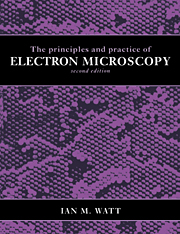Book contents
- Frontmatter
- Contents
- Preface to first edition
- Preface to second edition
- 1 Microscopy with light and electrons
- 2 Electron–specimen interactions: processes and detectors
- 3 The electron microscope family
- 4 Specimen preparation for electron microscopy
- 5 The interpretation and analysis of micrographs, pages 189 to 223
- The interpretation and analysis of micrographs, pages 224 to 262
- 6 Analysis in the electron microscope
- 7 Specialised EM- and other microscopical and analytical techniques
- 8 Examples of the use of electron microscopy
- Appendixes
- Bibliography
- Name index
- Subject index
7 - Specialised EM- and other microscopical and analytical techniques
Published online by Cambridge University Press: 05 June 2012
- Frontmatter
- Contents
- Preface to first edition
- Preface to second edition
- 1 Microscopy with light and electrons
- 2 Electron–specimen interactions: processes and detectors
- 3 The electron microscope family
- 4 Specimen preparation for electron microscopy
- 5 The interpretation and analysis of micrographs, pages 189 to 223
- The interpretation and analysis of micrographs, pages 224 to 262
- 6 Analysis in the electron microscope
- 7 Specialised EM- and other microscopical and analytical techniques
- 8 Examples of the use of electron microscopy
- Appendixes
- Bibliography
- Name index
- Subject index
Summary
Dark-field electron microscopy
In a transmission microscope the bright-field image is formed by electrons which have traversed the specimen without significant change in direction. Darker areas show where electrons have been deflected out of the beam and intercepted by the objective aperture, by atomic scattering if the specimen is amorphous or by Bragg reflections from a crystal.
It is often more informative to form the image using the deflected electrons rather than the transmitted beam, since one is then using only electrons which have actually interacted with the specimen. Examination modes based on this principle are known as dark-field modes, since the final screen is dark unless there is a specimen present to deflect electrons into the image (see, for example, Figure 7.1). The principle is the same as that used in dark-ground light microscopy and is similarly useful in showing up low-contrast detail more strongly. There are several ways in which dark-field observations can be made.
Displaced objective aperture
In normal bright-field microscopy the objective or contrast diaphragm is placed symmetrically about the axis of the objective lens and scattered electrons are absorbed by its periphery. If the diaphragm is displaced sideways it will absorb the direct beam and transmit electrons scattered or diffracted in its direction, so that the final image is formed only from these electrons (Figure 7.2(a)). If the specimen is crystalline the diaphragm may be moved so as to transmit only the electrons from a specific diffraction ring or spot so that areas of specimen with a particular crystallographic orientation will be highlighted in the image.
- Type
- Chapter
- Information
- The Principles and Practice of Electron Microscopy , pp. 303 - 333Publisher: Cambridge University PressPrint publication year: 1997

